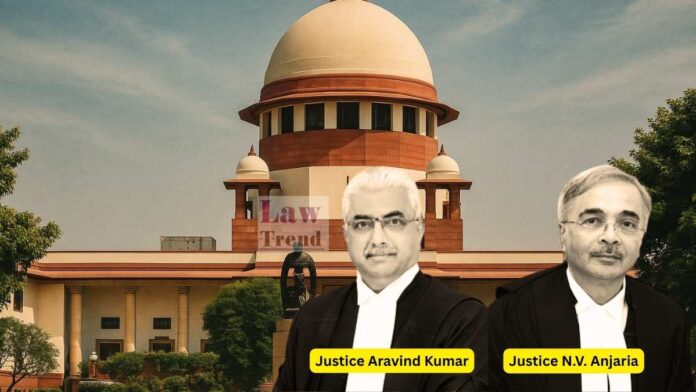The Supreme Court of India has upheld the conviction of a man under the Protection of Children from Sexual Offences Act, 2012 (POCSO Act), finding the “consistent and cogent” testimony of the 4-year-old victim’s mother to be confidence-inspiring. The Court also observed that the “trauma-filled behaviour” of the child victim in the courtroom, who became frightened upon seeing the accused, was “tale-telling” and a “pointer in itself.”
In a judgment delivered by a bench of Justice Aravind Kumar and Justice N.V. Anjaria, the Court partly allowed the appeal (Criminal Appeal No. 4732 of 2025) filed by the convict, Dinesh Kumar Jaldhari. While the conviction under Section 9(m) and Section 10 of the POCSO Act was affirmed, the Court modified the sentence, reducing the rigorous imprisonment from seven years to six years.
The appeal challenged the 06.03.2025 judgment of the Chhattisgarh High Court, which had confirmed the 18.04.2023 conviction and sentence order by the Special Judge (POCSO), Kunkuri, District Jashpur.

Background of the Case
According to the prosecution case, the incident occurred on 15.08.2021. The victim’s mother (PW-3) lodged an FIR (Crime No. 52 of 2021), reporting that her husband (PW-2), the appellant, and another man named Virendra had returned from collecting coal wood.
At approximately 4:30 p.m., the mother went inside the house to give food to the appellant. She stated that she found the appellant “had wore only half short (Chadda) and was sitting near the legs of her minor daughter aged 4 years.” When confronted by the mother, the appellant “stood up and ran away.”
The mother (PW-3) testified that she noticed her daughter’s “clothing of her daughter had gone inappropriate, and that her daughter was crying in pain.” The victim told her mother that “she had pain in her private part,” and the mother “found the private part of the daughter to be wet.” The child’s date of birth was established as 13.02.2017, making her between 4 and 5 years old at the time.
The Trial Court convicted the appellant under Section 9(m) and Section 10 of the POCSO Act, sentencing him to “seven years of rigorous imprisonment and further imposed a fine of Rs. 2,000/-.”
Arguments of the Parties
The appellant’s counsel assailed the conviction, contending that “there were no eyewitnesses to fortify the occurrence of incident” and the mother’s (PW-3) narration was “not supported by independent evidence.” It was further argued that the Medical Officer (PW-6) found “no marks of any external injury on the victim, nor there was bleeding on her private part.” The appellant’s counsel submitted that the “redness in the vagina seen could happen by rubbing over the clothes by the victim or due to infection,” and thus the appellant deserved the benefit of the doubt.
A final argument was made “that there was no suggestion of, much less evidence of penetration… and therefore the conviction and sentence was not justified.”
The advocate for the State of Chhattisgarh supported the conviction, submitting it was “based on clear facts, cogent circumstances and reliable evidence.”
The Supreme Court’s Analysis
The Supreme Court, examining the material evidence, found the testimonies of the victim’s mother (PW-3) and father (PW-2) to be “consistent.” The bench noted the detailed account provided by PW-3, including her observation that the “underwear of her daughter was down till her knees, and the frock was pulled up to the chest” and that her husband (PW-2) “hit him near the courtyard with a stick twice, but the appellant managed to flee.”
The Court concluded, “There is no good reason not to disbelieve the details revealed and the narration given about the incident by PW-3 mother of the victim.”
Regarding the medical evidence, the Court acknowledged that Dr. Priyanka Toppo (PW-6) “did not find external injury marks… and stated that there was no bleeding of any kind.” However, the Court relied on established legal principles, stating, “It is well settled that the medical evidence will take a backseat and even if do not corroborate with the ocular evidence, where the ocular evidence is consistent and cogent, the later would be allowed to prevail.” The Court also noted that “redness in the vagina of the victim was noticed.”
A significant part of the Court’s analysis focused on the testimony of the 4-year-old victim (PW-1). The judgment reproduced the trial court’s record, which stated that when the accused removed his mask, the witness “started getting frightened and did not look at the Accused.” The trial court had to stop the evidence “to make the Victim normal,” but when recording resumed, she was “not giving any answers and is crying.”
The Supreme Court observed, “The fact that the victim was in a frightened state upon seeing the accused is a pointer in itself. The whole sequence of events in course of recording of evidence of PW-1, was tale-telling.” The Court further added, “The shock related to the happening of the incident which continued with the victim post-incident made its statement in the trauma-filled behaviour of the victim who was a 4 year-old girl.”
In response to the appellant’s argument regarding the lack of penetration, the Court stated it was “not impressed with this submission, given the facts and evidence on record.”
The Final Decision
The Supreme Court concluded that “The evidence highlighted above go to establish the commission of offence” and that the appreciation of evidence by the lower courts was “eminently legal and proper, warranting no interference by this Court.”
The bench “resultantly upheld” the conviction.
On the quantum of sentence, the Court noted that the appellant had “so far undergone imprisonment for about 4 years and 5 months.” Finding this, “in the totality of the facts and circumstances,” the Court was “inclined to reduce the sentence requiring the appellant to undergo the rigorous imprisonment for 6 years, instead.”
The Court further ordered, “The imposition of fine of Rs. 6000/- and the simple imprisonment of one year in default of payment of fine would stand.”
The appeal was “partly allowed” to the limited extent of modifying the sentence.







